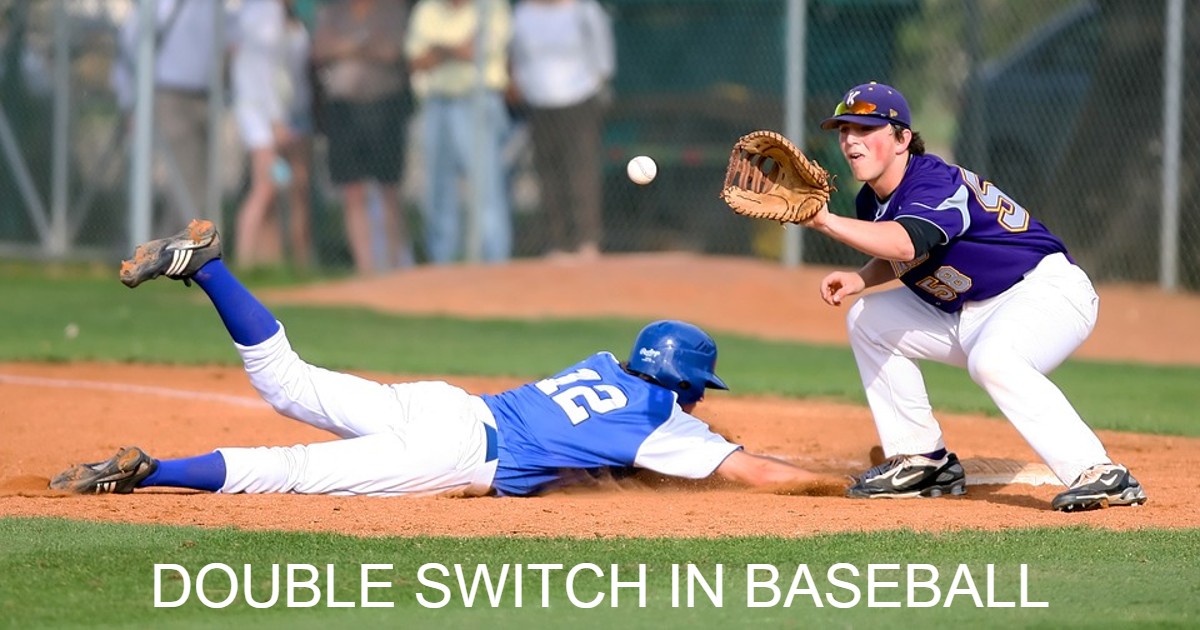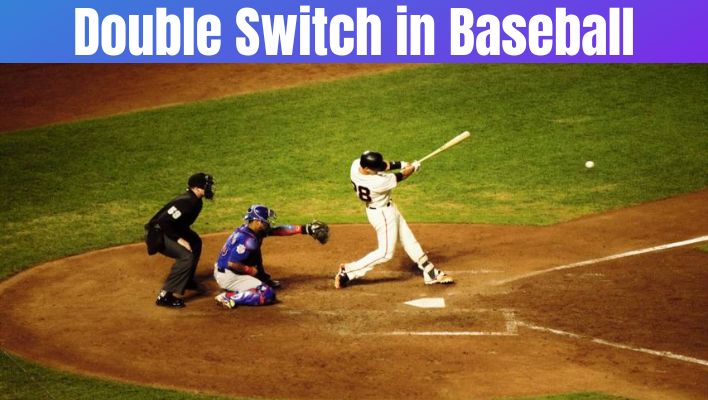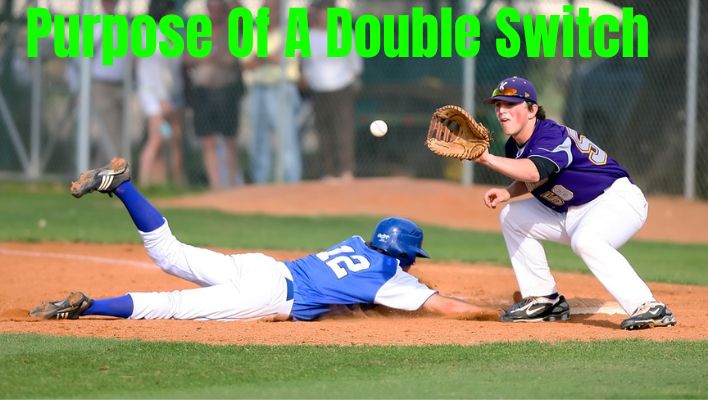A double switch in baseball is a tactical move that can be used by a team’s manager during a game to gain an advantage.
The strategy involves taking out two players at the same time, one from the field and one from the team’s bench. The player from the field is replaced by a player from the bench, and the player from the bench is inserted into the game as a defensive replacement on the field.
The main goal of a double switch is to create a favorable matchup for the team, such as putting a strong defensive player on the field or having a specific player hit against a certain pitcher. It’s a powerful tool that can help teams to win important games and make a difference in a close match.
Moreover, the double switch is most commonly used in the late innings of a game, when managers are looking to create a matchup that will give their team the best chance to win.
There are several different ways that a double switch can be used to create a favorable matchup. For example, a manager might bring in a strong defensive player to replace a player who is not known for their defensive skills.
Additionally, they might bring in a pinch-hitter for a player who is not hitting well. It can also be used to create a favorable matchup for a relief pitcher, depending on the opposing team’s lineup. With proper execution, a double switch can give a team a crucial edge over the opposition.

How does a double switch work?
Content Summery
A double switch in baseball works by allowing a team’s manager to replace two players at the same time, one from the field and one from the team’s bench. The player from the field is replaced by a player from the bench, and the player from the bench is inserted into the game as a defensive replacement on the field.
The process of a double switch typically begins with the manager informing the home plate umpire of his intentions. The manager will then select a player from the bench to replace the current player on the field and will also select a player from the field to be replaced.
The umpire will then signal for the new player on the field to take their position, and the new player on the bench will be officially entered into the game.
This allows the manager to create a favorable matchup for their team by replacing a player who may be struggling with one who may be more successful against the opposing team.
Why Do Double Switches Occur?
Double switches occur in baseball as a strategic move used by a team’s manager to gain an advantage during a game. The main goal of a double switch is to create a favorable matchup for the team by replacing one or more players in order to gain an edge over the opposing team.
There are several reasons why a manager might choose to use a double switch, including:
- Defensive Replacement: The team manager might bring in a strong defensive player to replace a player who is not known for their defensive skills in order to prevent runs from scoring and keep the game close.
- Pinch-Hitter: A manager might bring in a pinch-hitter for a player who is not hitting well, especially in the late innings of a game when the team is looking to score runs and take the lead.
- Relief Pitcher: A pitcher might bring in a relief pitcher who throws a certain type of pitch, such as a knuckleball, to take advantage of the fact that hitters tend to have more trouble hitting against that type of pitch.
- Opposing Team’s Lineup: Double switch can also be used to create a favorable matchup for the team depending on the opposing team’s lineup.
- To Exploit weakness: A coach might want to exploit the opposing team’s weakness by bringing in a player that has a good record against the opposing pitcher.
Overall, the double switch is a tactical move that allows the manager to make real-time adjustments in the game and exploit any opportunity that may arise to gain an advantage over the opposing team.

How Does the DH Affect the Double Switch?
The designated hitter (DH) rule, which is used in the American League but not in the National League, can affect the use of the double switch in baseball. The DH rule allows teams to have a player designated to bat in place of the pitcher, which can change the way managers use the double switch.
In the American League, the DH can be used as a “pinch-hitter” without the need for a double switch. A manager can simply replace the DH with a pinch-hitter without having to worry about replacing the DH in the field. This allows managers to have more flexibility and options when making changes to their lineup during the game.
On the other hand, in the National League, where the pitcher has to bat, the double switch can be used to bring in a pinch-hitter for the pitcher without having to take out a position player. This is particularly useful when a manager wants to give a relief pitcher a chance to hit.
In the American League, the use of the double switch can become less frequent due to the presence of the DH, but it still can be a valuable tool in situations where the manager wants to bring in a defensive replacement or change the defensive alignment of the team.
What is an example of a baseball double switch?
An example of a baseball double switch would be when a manager wants to bring in a defensive replacement for a player who is not known for their defensive skills.
For example, let’s say that the home team is playing the visiting team, and the home team’s manager wants to make a defensive change to strengthen the team’s defense.
The home team is currently playing in the top of the eighth inning, and the visiting team has a runner on second base with two outs. The home team’s shortstop, who is not known for his defensive skills, is currently playing on the field.
The Team manager decides to make a double switch and tells the umpire that he wants to replace the shortstop with a strong defensive player from the bench and bring in a pinch-hitter for the pitcher who is due to bat next.
The umpire signals for the defensive replacement to take the field and the pinch-hitter to take his place in the lineup. The defensive replacement takes over at shortstop, the pinch-hitter takes over the pitcher’s spot in the lineup, and the pitcher is removed from the game. This allows the home team to have a stronger defense on the field and a better chance to hit the opposing team’s pitcher.
Conclusion
In conclusion, the double switch is a tactical move that can be used by a team’s manager during a game to gain an advantage. The strategy involves taking out two players at the same time, one from the field and one from the team’s bench.
The player from the field is replaced by a player from the bench, and the player from the bench is inserted into the game as a defensive replacement on the field. The main goal of a double switch is to create a favorable matchup for the team, such as putting a strong defensive player on the field or having a specific player hit against a certain pitcher.
The double switch is most commonly used in the late innings of a game when managers are looking to create a matchup that will give their team the best chance to win.
The DH rule in American League can affect the use of the double switch, but it’s still a valuable tool for managers to make real-time adjustments in the game and exploit any opportunity that may arise to gain an advantage over the opposing team.

FAQs
Q. How is the double switch different from a traditional substitution?
A double switch is different from a traditional substitution in that it involves replacing two players at the same time, one from the field and one from the bench, whereas a traditional substitution only involves replacing one player at a time.
The double switch allows managers to create a favorable matchup by replacing a player on the field and a player on the bench at the same time, whereas traditional substitution only allows for the replacement of one player.
Q. What is the benefit of a double switch in baseball?
The benefit of a double switch in baseball is that it allows managers to create a favorable matchup for their team by replacing one or more players in order to gain an edge over the opposing team.
This can be done by bringing in a strong defensive player, a pinch-hitter, or a relief pitcher with a specific skill set, depending on the game situation. It allows managers to make real-time adjustments in the game and exploit any opportunity that may arise to gain an advantage over the opposing team.
Q. What makes the double switch difficult for managers to implement?
The double switch can be difficult for managers to implement because it can disrupt the flow of the game and take away from the continuity of the game. Additionally, it can also be risky to take out a player who is playing well in order to bring in a defensive replacement or pinch-hitter.
Managers have to weigh the potential benefits against the potential drawbacks before making the decision to use a double switch; it also requires precise timing and execution, which can be challenging, especially in high-pressure situations.
Q. Can you double-switch a DH (designated hitter)?
A DH (Designated Hitter) can be double-switched in the American League, where the DH rule applies. A manager can replace the DH with a pinch-hitter without having to worry about replacing the DH in the field.
However, the DH can’t be double-switched in the National League, where the pitcher is required to bat; thus, the DH doesn’t exist. In other words, the DH can’t be replaced by a pinch-hitter, as there’s no need to replace the player in the field.
